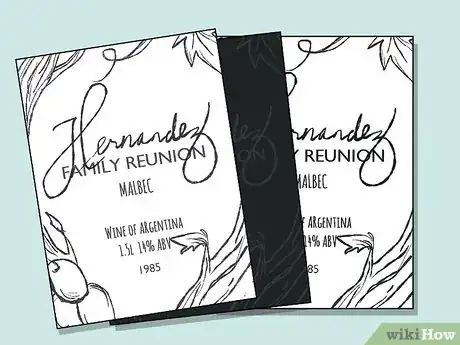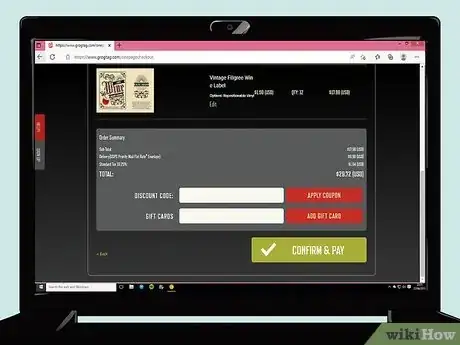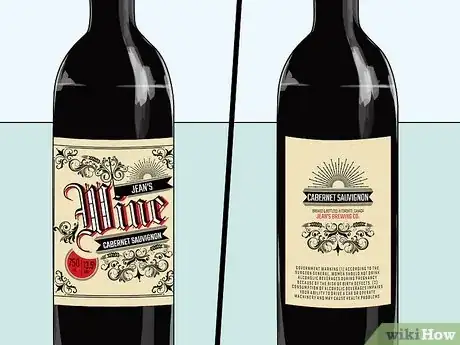This article was co-authored by Murphy Perng. Murphy Perng is a Wine Consultant and the Founder and Host of Matter of Wine, a business that produces educational wine events, including team-building experiences, networking events, and private parties. Based in Los Angeles, California, Murphy has served as a Wine Educator for clients such as Google, Buzzfeed, Tiktok, Snapchat, and Equinox and been featured on National Geographic and The Somm Journal. Murphy possesses her WSET (Wine & Spirit Education Trust) Level 3 Advanced Certification.
There are 7 references cited in this article, which can be found at the bottom of the page.
This article has been viewed 53,113 times.
Wine is a sophisticated addition to any meal, and the first impression any wine makes is with its label. Wine labels can be made for special occasions or to give a home bottling a professional appearance. You can make wine labels by hand, create them digitally on the computer, or use an established label service online to make your wine bottles look their very best.
Steps
Making Labels by Hand
-
1Brainstorm your design. Take some time to think about your wine and what you want your wine label to accomplish. Is the wine is for an occasion, like a wedding or Christmas? Or is it an all-season wine? Do you want the wine to be perceived as serious or fun? Make a list of any visual images that come to mind that you’d like to incorporate in your design.[1]
- It can be helpful to visit your local wine store and take note of any labels you feel particularly drawn to. Note what you like about them and take a few pictures for inspiration.
- You can also explore wine merchants and check out labels for inspiration online.
-
2Select a label size. Wine label paper comes in any number of sizes up to standard letter (8.5 in by 11 in or 26 cm by 28 cm). This is much larger than any potential wine bottle. Experiment with different size labels by buying a full sheet of labeling paper and cutting out sample labels of different dimensions. This will help you determine the size and shape of label you like best.Advertisement
-
3Sketch your label on plain paper. Draw a “label” of the shape and dimensions you’ve determined are best on a sheet of blank letter paper. Sketch a design based on the ideas you brainstormed. You can try experimenting with a few designs to narrow down your favorite. Once you’ve determined the direction you want to go, draw a clean copy of your design to the right dimensions.
-
4Use transfer paper to imprint your template onto your labels. Use artist tape to secure a piece of graphite transfer paper on top of an actual label you’ll be using for your wine bottles. Ensure all the edges are secured tightly and that there is no movement between the two pieces. Place your design template on top, and begin tracing firmly with a pencil. This will transfer your design to your label seamlessly.[5]
-
5Trace your design with permanent marker. Use permanent markers to color in or add wording to your design on the label as desired. This will ensure your label is colorfast.
-
6Stick your label on your wine bottle. Remove the backing off the wine label to expose the sticky side. Start at one side and press the label smoothly over the surface of the bottle, taking care not to trap any air bubbles.
- It can be helpful to let the labels and bottles come to room temperature for the best application.[6]
-
7Seal your label to prevent water damage. Use a clear acrylic sealant, such as Krylon Crystal Clear, to waterproof your new label. Follow the manufacturer’s directions regarding any ventilation, spraying distance and curing time to ensure the best result. Most sprays take at least two hours to dry completely.
-
8Repeat this process for additional wine bottles. Use your template to make more labels as desired. Seal your wine labels to prevent smudging.
Creating Labels Digitally
-
1Conceptualize a design. Brainstorm about what kind of label would be the best fit for your wine. This can be driven by the style of wine, whether it’s been made for a special occasion, and the impression you’d like the wine to impart. Make a list of any visual images that come to mind that you’d like to incorporate in your design.[7]
- Check out other wine labels to get design ideas. You can take photos of your favorites to note any cool color combinations or themes.
-
2Use design software to create your label. Use design software, such as Adobe InDesign or Print Artist Platinum Plus, to craft a label. There are lots of online tutorials specific to wine-label making that can help you create the exact effects you want. Since you’re creating your labels with software, you also have the option of incorporating photos and other interesting graphics.[8]
- Make sure you have the rights to any graphic images you decide to use. You can purchase rights to images on many photo sites such as Getty Images and Corbis.
-
3Buy sheets of wine labels. Online wine product stores, such as Grapestompers.com, provide many different colors and sizes of wine labels made to be printed on with a home printer. You can purchase labels that are already cut or a large sheets that can be tailored to unusual shapes or sizes.
-
4Print your design onto the labels. Load the labels into your printer, previewing your print beforehand to ensure proper alignment. Print the labels, letting them dry completely before handling.
-
5Stick the labels on the bottles. Expose the sticky side of the wine label by removing the protective backing. Start at one side of the label and press it smoothly over the surface of the bottle. Be careful not to trap any air bubbles as you smooth.
- For the best application, let the labels and bottles come to room temperature first.[9]
-
6Seal your label to prevent damage. Follow the manufacturer’s directions on a clear acrylic sealant, such as Krylon Crystal Clear, to spray your printed label. These sealants are sold in most craft stores. Many sealants take an hour or two to cure fully, so wait at least that long before handling your labels.
Using an Internet Label Service
-
1Pick a template or upload a custom design. Wine label websites, such as Bottleyourbrand.com and Grogtag.com, provide easy ways to make wine labels online. Both have extensive collections of designs you can customize to your liking, or you can upload a custom design and have it professionally printed and delivered by them.[10]
- Create an original design with computer software, such as Adobe InDesign or Print Artist Platinum Plus, if you would like one. Online wine label tutorials on YouTube can help you create a look that is unique to your wine.[11]
-
2Customize your template or upload your custom design. If you’re going with a template, customize it with the name of your wine, the alcohol by volume, and any other information you’d like to include about your vineyard or event. If you’re uploading your own custom label, all that information should already be included.
-
3Place your order. Look over your label design to double check all details for accuracy. If everything looks good, finalize your order. Your labels will be sent to you in the mail.
-
4Adhere the labels to your wine bottles. When the labels arrive, lay out your wine bottles. Remove the backing of a label and press it smoothly over the area you want to place it on the bottle, being careful not to trap any air bubbles during application. Repeat with each additional bottle and label.[12]
Expert Q&A
-
QuestionWhat are the different tastes of wine?
 Murphy PerngMurphy Perng is a Wine Consultant and the Founder and Host of Matter of Wine, a business that produces educational wine events, including team-building experiences, networking events, and private parties. Based in Los Angeles, California, Murphy has served as a Wine Educator for clients such as Google, Buzzfeed, Tiktok, Snapchat, and Equinox and been featured on National Geographic and The Somm Journal. Murphy possesses her WSET (Wine & Spirit Education Trust) Level 3 Advanced Certification.
Murphy PerngMurphy Perng is a Wine Consultant and the Founder and Host of Matter of Wine, a business that produces educational wine events, including team-building experiences, networking events, and private parties. Based in Los Angeles, California, Murphy has served as a Wine Educator for clients such as Google, Buzzfeed, Tiktok, Snapchat, and Equinox and been featured on National Geographic and The Somm Journal. Murphy possesses her WSET (Wine & Spirit Education Trust) Level 3 Advanced Certification.
Certified Wine Consultant It can be sweet and have different levels of sugar. If it is dry, it means it has no sugar. If it is luscious, it has a lot of sugar. It may have acidity and be more on the sour side. It may have tannin that makes your mouth almost dry out.
It can be sweet and have different levels of sugar. If it is dry, it means it has no sugar. If it is luscious, it has a lot of sugar. It may have acidity and be more on the sour side. It may have tannin that makes your mouth almost dry out. -
QuestionIs cake and champagne a good combination?
 Murphy PerngMurphy Perng is a Wine Consultant and the Founder and Host of Matter of Wine, a business that produces educational wine events, including team-building experiences, networking events, and private parties. Based in Los Angeles, California, Murphy has served as a Wine Educator for clients such as Google, Buzzfeed, Tiktok, Snapchat, and Equinox and been featured on National Geographic and The Somm Journal. Murphy possesses her WSET (Wine & Spirit Education Trust) Level 3 Advanced Certification.
Murphy PerngMurphy Perng is a Wine Consultant and the Founder and Host of Matter of Wine, a business that produces educational wine events, including team-building experiences, networking events, and private parties. Based in Los Angeles, California, Murphy has served as a Wine Educator for clients such as Google, Buzzfeed, Tiktok, Snapchat, and Equinox and been featured on National Geographic and The Somm Journal. Murphy possesses her WSET (Wine & Spirit Education Trust) Level 3 Advanced Certification.
Certified Wine Consultant Sweet items go along well with a sweet wine. The cake has plenty of sugar, but the champagne has very little sugar. It has only zero to six grams of sugar. So it is better to serve the cake with some other sweeter wine.
Sweet items go along well with a sweet wine. The cake has plenty of sugar, but the champagne has very little sugar. It has only zero to six grams of sugar. So it is better to serve the cake with some other sweeter wine. -
QuestionWhat is the best position to keep a wine bottle?
 Murphy PerngMurphy Perng is a Wine Consultant and the Founder and Host of Matter of Wine, a business that produces educational wine events, including team-building experiences, networking events, and private parties. Based in Los Angeles, California, Murphy has served as a Wine Educator for clients such as Google, Buzzfeed, Tiktok, Snapchat, and Equinox and been featured on National Geographic and The Somm Journal. Murphy possesses her WSET (Wine & Spirit Education Trust) Level 3 Advanced Certification.
Murphy PerngMurphy Perng is a Wine Consultant and the Founder and Host of Matter of Wine, a business that produces educational wine events, including team-building experiences, networking events, and private parties. Based in Los Angeles, California, Murphy has served as a Wine Educator for clients such as Google, Buzzfeed, Tiktok, Snapchat, and Equinox and been featured on National Geographic and The Somm Journal. Murphy possesses her WSET (Wine & Spirit Education Trust) Level 3 Advanced Certification.
Certified Wine Consultant You should lay your wine bottle horizontally, especially if it has a cork. When it comes into contact with the wine, it expands and fills the neck. A minimum amount of air enters the bottle, and the wine remains intact.
You should lay your wine bottle horizontally, especially if it has a cork. When it comes into contact with the wine, it expands and fills the neck. A minimum amount of air enters the bottle, and the wine remains intact.
Things You'll Need
- Sketching paper
- Transfer paper
- Artist tape
- Permanent markers
- Label material
- Computer
- Software
- Printer
- Clear acrylic sealant
- Wine bottles
References
- ↑ https://www.forbes.com/sites/susanadams/2013/03/05/4-steps-to-successful-brainstorming/#1f3f2a455992
- ↑ Murphy Perng. Certified Wine Consultant. Expert Interview. 15 March 2019.
- ↑ Murphy Perng. Certified Wine Consultant. Expert Interview. 15 March 2019.
- ↑ Murphy Perng. Certified Wine Consultant. Expert Interview. 15 March 2019.
- ↑ https://www.art-is-fun.com/transfer-paper/
- ↑ https://www.camcode.com/adhesive-instructions.html
- ↑ https://www.forbes.com/sites/susanadams/2013/03/05/4-steps-to-successful-brainstorming/#1f3f2a455992
- ↑ https://www.youtube.com/watch?v=ItIDu4R1z0c
- ↑ https://www.camcode.com/adhesive-instructions.html







































































